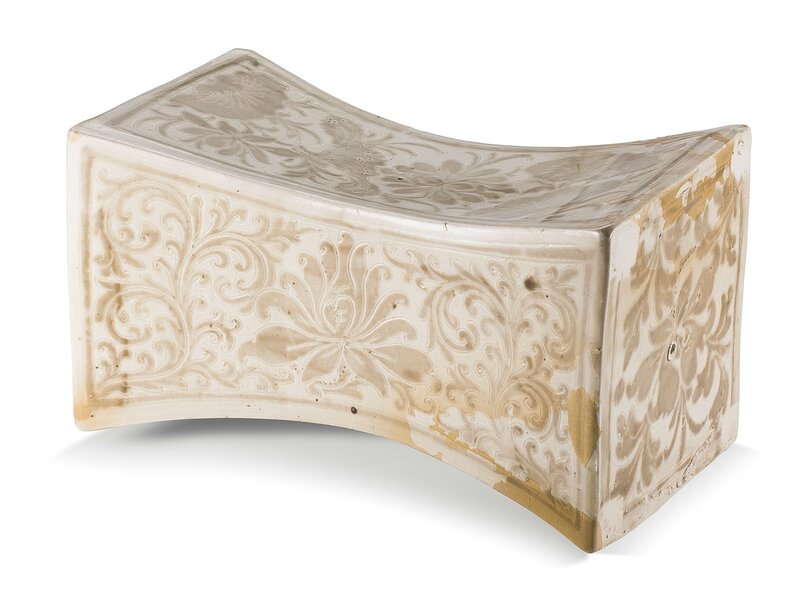A rare 'Ding' slip-decorated 'lotus' pillow, Song dynasty
Lot 670. A rare 'Ding' slip-decorated 'lotus' pillow, Song dynasty. Estimate 150,000 — 200,000 HKD. Lot sold 275,000 HKD. Photo: Sotheby's.
of waisted rectangular form, painted in pale russet-brown on an ivory-white ground, each face of the pillow depicting luxuriant floral blooms borne on curling stems issuing foliate tendrils and large lotus pads with furled edges, all beneath a transparent glaze; 28 cm, 11 in.
Notes: Notable for its freely carved design of curling lotus flowers, this pillow is a rare example of Ding-type ware with sgraffiato decoration. This laborious technique required the application of a layer of brown slip to the white body, which is then carved and incised to form the pattern and reveal the white body beneath, hence creating a particularly vivid and attractive contrast. Qin Dashu in ‘A Study of the Relationship between Cizhou and Ding Wares’, Transactions of the Oriental Ceramic Society, vol. 65, 2000-2001, pp. 10 and 11, notes that the light brown tones of the coloured slip seen on Ding-type wares with sgraffiato designs, such as this pillow, was due to a shortage of ore with high iron content near the Ding kilns.
Three pillows carved with this technique, in the Palace Museum, Beijing, have been published: one, decorated with a lotus scroll on the top and inscribed with a cyclical date corresponding to 1168, is illustrated in The Complete Collection of Treasures of the Palace Museum. Porcelains of the Song Dynasty (I), Hong Kong, 1996, pl. 89; and two, both incised with a leafy scroll, are included in Selection of Ding Ware. The Palace Museum Collection and Archaeological Excavation, Beijing, 2012, pls. 100 and 101. See also a pillow of this type, excavated at Dingzhou, Hebei province, illustrated in Mu Qing, Ding ci yishu [The art of Ding porcelain], Shijiangzhuang, 2002, pl. 200; one in the National Museum of China, Beijing, included in the exhibition Ding Kiln of China, Beijing Art Museum, Beijing, 2012, pl. 11; another, in the Tianjin Museum, illustrated in Porcelains from the Tianjin Municipal Museum, Beijing, 1993, pl. 29; and a further pillow, from the Meiyintang collection, illustrated in Regina Krahl, Chinese Ceramics from the Meiyintang Collection, vol. 3 (II), London, 2006, pl. 1538.
Sotheby's. Chinese Art, Hong Kong | 02 Jun 2016

/https%3A%2F%2Fprofilepics.canalblog.com%2Fprofilepics%2F1%2F0%2F100183.jpg)
/https%3A%2F%2Fstorage.canalblog.com%2F03%2F02%2F119589%2F96711876_o.jpg)
/https%3A%2F%2Fstorage.canalblog.com%2F11%2F31%2F119589%2F94773502_o.jpg)
/https%3A%2F%2Fstorage.canalblog.com%2F20%2F83%2F119589%2F94772815_o.jpg)
/https%3A%2F%2Fstorage.canalblog.com%2F26%2F72%2F119589%2F75604929_o.jpg)
/https%3A%2F%2Fstorage.canalblog.com%2F59%2F60%2F119589%2F26458628_o.jpg)





/image%2F1371349%2F20240315%2Fob_7bd30a_431977340-1633099410793405-26442445716.jpg)
/http%3A%2F%2Fstorage.canalblog.com%2F28%2F38%2F119589%2F129504991_o.jpg)
/http%3A%2F%2Fstorage.canalblog.com%2F47%2F86%2F119589%2F129060970_o.jpg)
/http%3A%2F%2Fstorage.canalblog.com%2F33%2F75%2F119589%2F129054916_o.jpg)